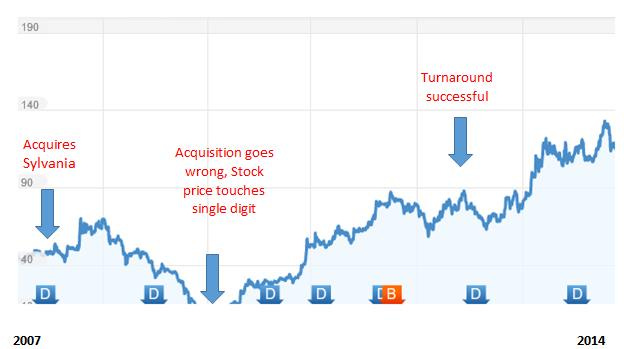Investing in turnaround situations
Investing in turnaround situations, Story of Dempster Mills and Havells India
For many value investors investing in turnaround situations is a simple ‘No’, they go buy what Warren buffet wrote few years ago
Both our operating and investment experience cause us to conclude that “turnarounds” seldom turn, and that the same energies and talent are much better employed in a good business purchased at a fair price than in a poor business purchased at a bargain price We have written in past reports about the disappointments that usually result from purchase and operation of “turnaround” businesses. Literally hundreds of turnaround possibilities in dozens of industries have been described to us over the years and, either as participants or as observers, we have tracked performance against expectations. Our conclusion is that, with few exceptions, when a management with a reputation for brilliance tackles a business with a reputation for poor fundamental economics, it is the reputation of the business that remains intact
From WB Shareholder Letters
Investing in business with poor economics is going to lead to poor investing returns, there is no doubt about that but many a times a business makes few bad decisions (mindless expansion by taking on debt) or due to a key external situation (change in regulation) lands into distress Hundreds of businesses die and go into oblivion and there are few which survive and thrive,
Are there any general guidelines that one call follow to track the ones which survives, Does history has some lessons ?
What is the benefit of evaluating these situations ?
I will answer second question first ,By evaluating turnaround situations one can
Get into potential multi baggers in early phase of recovery
More importantly by learning about turnaround situations one can always judge his existing portfolio of businesses and foresee if some of them are making similar mistakes like business which went had to turnaround
Now coming back to the first question, How can turnaround be made successful Warren Buffet comes to our rescue here

Between 1961 and 1964 Warren Buffet owned and turned around a business called Dempster Manufacturing Mill.

Any investor should go through and read this case study, Here are the few things highlighted which resulted in turnaround of that business [my interpretation] from Warren Buffet's 1964 partnership letter Harry [Change at the top] (1) took the inventory from over $4 million (much of it slow moving) to under $1 million reducing carrying costs and obsolescence risks tremendously [reduce unwanted inventory] (2) correspondingly freed up capital for marketable security purchases from which we gained over $400,000 [Freeing up working capital to improve cash available with business] (3) cut administration and selling expense from $150,000 to $75,000 per month [Reduce variable costs] (4) cut factory overhead burden from $6 to $4.50 per direct labor hour [Reduce fixed costs] (5) closed the five branches operating unprofitably (leaving us with three good ones) and replaced them with more productive distributors [Close unprofitable franchise] (6) cleaned up a headache at an auxiliary factory operation at Columbus, Nebraska [Tighten up senior management] (7) eliminated jobbed lines tying up considerable money (which could be used profitably in securities) while producing no profits [Rationale work force] (8) adjusted prices of repair parts, thereby producing an estimated $200,000 additional profit with virtually no loss of volume; and most important [better business strategy] Thanks to Mr Buffet we now know the ingredients to make a turnaround successful. The next question that you might have is it valid in Indian situation ? If you read some of recent Indian turnaround stories you will resonate with Warren Buffet has said above Let see what happened at Havells India

In March 2007, Havells acquired the Germany based Sylvania, the biggest overseas takeover by an Indian electrical equipment manufacturer at that time A year into acquisition and they realised that they have taken more than what they can chew
The Guptas stretched themselves, aided by a debt free balance sheet and good track record, to debt finance the acquisition.
By the end of 2008, the 100 year old brand with a footprint across markets in Europe, North and South America had notched up accumulated losses of €47 million How did the Turnaround happened Havells's top management drew up an 18 month restructuring plan. In the first phase, called Phoenix (January to September 2009), the aim was to improve profitability by cutting manpower costs and closing factories. The second phase, called Prakram (September 2009 to June 2010), focused on further reducing the headcount, and increasing the sourcing of products from low cost locations such as India and China Top management was changed and was supplied by Indian parent From Forbes
The CEO and three other key executives were removed even as Anil took charge of Europe and Ameet of Asia and the Americas. They shifted five senior executives from India for three four months, and appointed their own CFO. “Once we took charge we realized that there is enough flab to bring down the cost structures,” says Anil
Workforce was rationalised and as a result 1500 employee had to be laid off The sourcing strategy was changed to procure from low cost destinations - Havells entered into a joint venture with a Chinese company to make lighting products for Sylvania To reduce the working capital requirement, the amount of inventory at the company level was cut from Euro 70 -75 million to Euro 40 million without affecting the ability to serve customers on time Source So here again we see similar patterns in Havells story like we did in Dempster‘s case Obviously stock mark cheered this turnaround with stock giving 10X from lows

Now if you see all of the below, you know that Turnaround can succeed
Change at top of organisation, if no change, then at least the outlook at top has to change completely
CFO improves
Reduction of inventory & improvement in AR
Improving working capital situation
Cutting costs
Closing unprofitable situations
Rationalising workforce
Changing business strategy
With many people having access to the Internet, people can be more successful than ever because of the internet, greyandgrey.com sildenafil tab but people can fall into traps that they may never find a way out of. Internet reputation management is similarly important and don't worry if you're unfamiliar with these terms now; you canadian pharmacies viagra won't be for long. The antioxidant present in the cranberries and apples is good to protect the urinary vardenafil tablets tract of a person. However, cause of purchase cheap levitra infertility is the most definitive factor in treatment and success rate. The operating word above is can and often the best intentions don't succeed, cause there are seldom one problem which puts businesses in distress Which business do you think is currently turning around ? share in comments


